
ICM 1/72 Polikarpov IL-400B
|
KIT # |
72051 |
|
PRICE: |
Approx $10.00 |
|
DECALS: |
One aircraft |
|
REVIEW: |
|
|
NOTES: |

|
HISTORY |
" ПЕРВЫЙ ИСТРЕБИТЕЛ СОВЕТСКОГО СОЮЗА"
POLIKARPOV IL-400B
G. A. Z. NO. 1 (STATE AIRCRAFT FACTORY NO. 1)
KHODINKA, MOSCOW, USSR - 1924
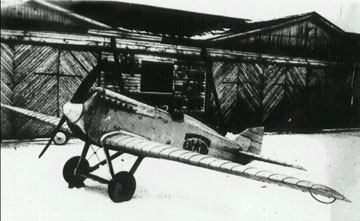
Working at the former Duks factory (GAZ 1) in 1922, Nikolai Polikarpov, assisted by I. M. Kostkin, designed a conceptually advanced monoplane fighter, the IL-400 (I for Istrebitel, L-400 for Liberty-400 hp). The IL-400 was a cantilever low-wing monoplane of wooden construction powered by a 400 hp Liberty water-cooled engine.
The prototype first flew on August 15, 1923. During the take off run, the aircraft left the ground prematurely and went into a steep climb, despite the fact that the pilot had the control column full forward. At a height between 15 and 150 feet (many varying reports, none substantial) with its nose still high, the aircraft stalled, so the pilot cut off the engine and the plane crashed falling backwards in the vertical position. Luckily the Soviet test pilot K. K. Artseulov escaped with only minor injuries.
Detailed wind tunnel tests proved that the aircraft was very unstable due to the incorrect position of its center of gravity (cg). It was found that even a slight departure from the optimum cg had an adverse effect on the airplane's longitudinal stability. A revised engine mount moved the engine further forward and cured the problem.
After an extensive redesign, both aerodynamic and structural, the aircraft was named the IL-400B (also referred to as IL-400bis), that first flew on July 18, 1924 with test pilot K. K. Artseulov again at the controls. The new plane retained the plywood-covered fuselage mated with entirely new wings, horizontal tail, and rudder constructed of corrugated and ribbed aluminum. Armament was provided in the form of two synchronized 7.62-mm machine guns mounted in the upper cowling and firing through the propeller arc. At first a Lambdin-type radiator was used between the landing gear struts, but this soon gave way to a honeycombed radiator mounted flush with the underside of the forward fuselage. Subsequent testing by A. I. Zhukov and A. N. Yekatov was done and in October 1924, the IL-400B was cleared for production and designated I-1 (Fighter-1).
A total of 33 I-1s were ordered, but only 18 were built. Production aircraft returned to using an all-wood airframe, as aluminum was costly and wood was plentiful. All 18 differed to some degree, but all I-1s required great skills from their pilots and would stall in a steep climb in addition to having difficulty in pulling out of a flat spin. It was in one of the production I-1s that Soviet test pilot M. M. Gromov made the first parachute escape in the USSR. No real answer was ever found and the I-1 was considered unusable by the VVS, therefore production was stopped. Although it did not meet the VVS criteria, the I-1 was a great leap forward for Soviet design engineers and at the time one of the fastest fighter planes in the world with a top speed of 164 mph.
The model represents the second prototype aircraft IL-400B and can be constructed with or without the Lambdin-type radiator. The Cyrillic title on the plaque;
" ПЕРВЫЙ ИСТРЕБИТЕЛ СОВЕТСКОГОСОЮЗА" or "PERVIY ISTREBITEL SOVETSKOGO SOYUZA" means "FIRST FIGHTER OF THE SOVIET UNION".|
THE KIT |
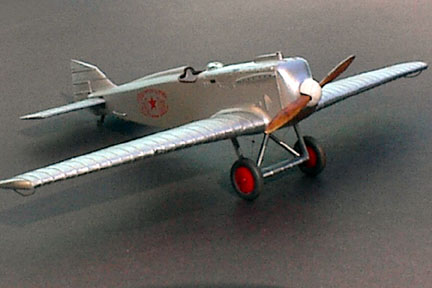
Except for adding the landing gear's wire bracing and a couple of seat belts from masking tape painted leather, there are no other modifications to the kit. The kit instructs the modeler to build the fuselage handholds, pitot, and under wing tip braces from wire or sprue. I used fine copper wire, as it bends and cuts easily. This was a very pleasant departure from super detailing and the kit fit nearly as well as anything for Tamiya and Hasegawa. It also did not possess that greasy substance found on the ICM Yak series in 1/48 scale. I look for more 1/72 scale models from this manufacturer, especially if all go together as well as this kit. Highly recommended for all modelers, young and old, just don't lose that tiny rear strut and windshield.
|
PAINT & DECALS |
Interior:
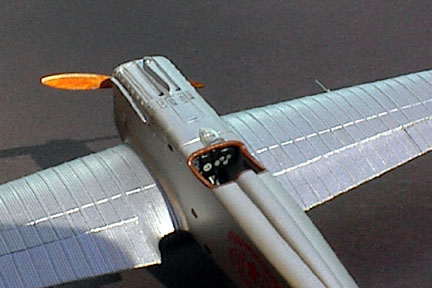
The interior was painted Polly Scale SF Silver, with the instrument panel pained black. The instrument gauges were done with Waldron punched disks of white trim film and Reheat Models instrument decals. I also used a few of Reheat Models' control and data placard decals. The control stick grip was painted flat black and the seat cushion painted leather and given a semi-gloss clear coat. The molded rudder pedals were shadowed with India ink and decals to give them some dimension. Machine gun breeches were painted gunmetal. This is a very simple interior, which would really give the detailist something to work with. Not having any reference to go by and wanting to build this model out-of-the-box, I left it alone.
Exterior:
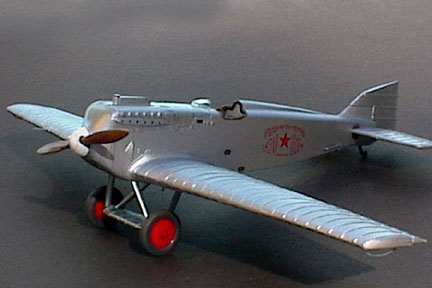
The fuselage was painted SF silver, which is already a smooth finish paint and requires no clear gloss for decals. The main fuselage was masked and the upper cowling was painted Polly Scale Bright Silver as were the wings, rudder, horizontal tails and landing gear struts and axle fairing. The model includes a main wing spar onto which the cockpit fits, so that the wings may be left off until final assembly and painted separately, very nice.
The instructions would have one paint the wheel centers bright aluminum, but in the two photo references I have, the wheel centers are dark and may even be black, but I deciphered them as red since old orthochromatic film displays red as black. Therefore, I painted them MM Guards Red. Tires were brushed with AeroMaster Tire Black and given a moderate mud wash. The rear strut was painted MM Wood as was the propeller. Both of these items were given dry brushings of dark brown, light earth, and black (be very subtle with the black). The propeller guards were brushed Polly Scale Copper and finished with a coat of clear gloss. The flush mounted radiator was also painted copper and given a black wash. I left off the Lambdin-type radiator, as it was not shown in my reference photos. The instructions also call for the propeller spinner to be painted bright aluminum, but my reference clearly shows this item as white, so I painted the spinner thusly. Machine gun barrels were painted gunmetal and the coolant cap painted steel.
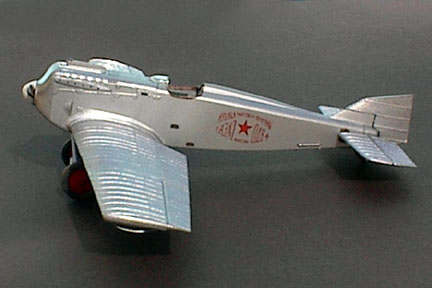
Decals from the kit were used and there are only two for the fuselage sides. They went on with no hassle, but give them plenty of time before trying to remove them from their paper backing after immersion in water. Since there were no recesses or raised areas involved, I only used a setting solution, as a solvent was not required. For the curious and inquisitive The Cyrillic transliterations and translations are as follows:
Крылья Мировой Коммуны or Kril'ya Mirovoy Kommuni (The Wings of the Commune of the World); Г.А.З. N 1 or G. A. Z. No. 1(State Aircraft Factory No. 1); "ИМЕНИ" or "IMENI" means "by the name", and О.Д.В.Ф. is the acronym for Общество Друзей Воздушного Флота or Obshchestvo Druzey Vozdushnogo Flota, (The Society of the Friends of the Air Fleet).After the decals had dried, I sealed them with a coat of clear gloss. I next masked the upper fuselage cowling cover and gave the fuselage a coat of clear flat. All subassemblies were then added, all attached with PVA glue. Now I have a beautiful model of a very rare subject. Applause to all at ICM.
|
ACKNOWLEGEMENTS |
Special thanks again to Boris Krotkov of Zelenograd, Russia for his aid in transliteration and translation of the Cyrillic text and for additional information not found in my references.
Copyright ModelingMadness.com. All rights reserved. No reproduction in part or in whole without express permission from the editor.
Back to Reviews Page 2023